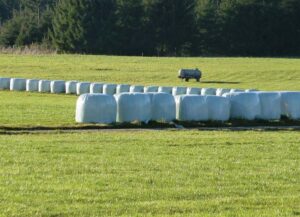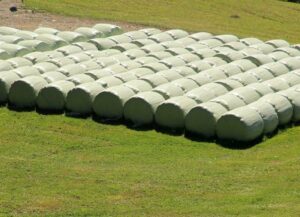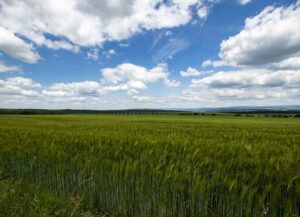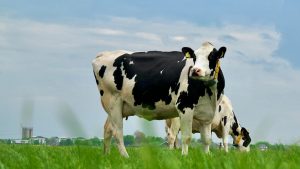Maria Villagrasa & Fernando Diaz
From an economic standpoint the plant species most suitable to be consumed by livestock, are those with a high and stable biomass production, that tolerate cold, drought, and other adverse environmental factors and that in general, have not very demanding growth needs.
Fescue (Festuca arundinacea Schreb.) is a cold season grass that meets all these criteria and is distributed throughout a wide range of climates. Native to Europe and North Africa, fescue is a widely adapted grass species with natural populations located from arid to very humid regions.
Fescue can withstand drought better than other cold-season pastures such as perennial ryegrass (Lolium perenne L.) or Kentucky blue grass (Poa pratensis L.). Although most of its total biomass production occurs during the spring, fall growth can be significant with adequate moisture and nitrogen application.
Fescue is commonly preserved as hay or silage and can produce high-quality forage, with high digestible energy, protein and minerals. Its composition however, as in other grass species, depends largely on the stage of maturity in which it is harvested.
Timothy (Phleum pratense L.) is one of the main perennial grass species grown in the cold and humid regions of northeastern North America and stands out for its good yield under cold conditions. However, warm and dry summers can negatively affect productivity and nutritional value which reduces its advantage over other pasture species for forage.
Thanks to its better tolerance to dry periods, fescue can be a good alternative to timothy. To verify this hypothesis a study (Richard et al., 2020) evaluated the effect of replacing timothy silage with fescue silage on dry matter intake (DMI) and the production and composition of milk in lactating Holstein cows.
Two diets (70:30 forage:concentrate ratio) made with timothy silage and fescue silage were compared.
The nutritional composition of timothy relative to fescue silage was: dry matter 31.3 vs. 34.1% fresh matter, organic matter 91.6 vs. 90.3% DM, protein 15.4 vs. 13.6% DM, neutral detergent fiber (NDF) 58.3 vs. 54.3% DM, acid detergent fiber (ADF) 38.5 vs. 35.3% DM, net energy of lactation (NEL) 1.23 vs. 1.26 Mcal/kg, total fatty acids 1.99 vs. 2.12% DM, in vitro digestibility 86.3 vs 86.1% DM, and NDF in vitro digestibility 76.4 vs. 74.4% NDF.
The composition of the timothy silage diet compared to that of the fescue silage was: dry matter 33.8 vs. 34.1%, organic matter 92.4 vs. 91.7%, protein 14.9 vs. 13.8%, NDF 43.8 vs. 39.8%, and ADF 28.0 vs. 25.2%.
Milk production and composition
Diets did not affect DMI (22.6 kg/day) a result that is consistent with other studies that found that DMI was similar for fescue and other pasture species, provided they were harvested at the same stage of development.
Diets also did not affect energy-corrected milk production (27.9 g/day), or fat-corrected milk (27.7 g/day), there were no differences in fat concentration (4.27%), and fat (1,137 g/day) and lactose (1,198 g/day) yields, although concentration of the latter was lower in cows on timothy silage (4.41 vs. 4.49%).
Similarly, other research indicates milk production in cows fed different pasture species was similar, provided the digestibility of the forage organic matter was also similar. In this experiment, timothy and fescue silages had similar in vitro digestibility (86.2% MS).
Moreover, the concentration of urea nitrogen in milk (MUN) was higher in cows receiving the timothy silage diet (9.0 vs. 6.5 mg/dL), and the same trend was observed in ruminal ammonia concentration (10.1 vs. 9.09 mg/dl) which could be due to the difference in protein concentration between both silages.
Similarly, milk protein concentration was higher when cows were fed timothy compared to fescue silages (3.53 vs. 3.40%) suggesting a shortage of N in the latter.
Rumen fermentation
Ruminal pH was similar between cows fed both diets (6.37 on average). These relatively high values are the result of high NDF concentrations (> 34.7%) in the experimental diets. The molar ratio of propionate in the rumen was higher when cows received the diet with fescue silage compared to that with timothy (19.7 vs. 17.5%), resulting in a lower ratio of acetate to propionate (3.5 for fescue and 4.1 for timothy). This effect could be related to the lower NDF concentration in fescue silage compared to timothy silage.
Conclusion
Feeding cows in lactation with fescue or timothy silage did not affect dry matter intake, milk production or milk fat concentration. These results confirm the potential of the use of fescue silage to substitute for timothy silage in dairy cow diets.
Reference
A.-M. Richard, R. Gervais, G. F. Tremblay, G. Bélanger, and É. Charbonneau. Tall fescue as an alternative to timothy fed with or without alfalfa to dairy cows. 2020. J. Dairy Sci. 103:8062–8073.
© 2020 Dairy Knowledge Center. All Rights Reserved.









